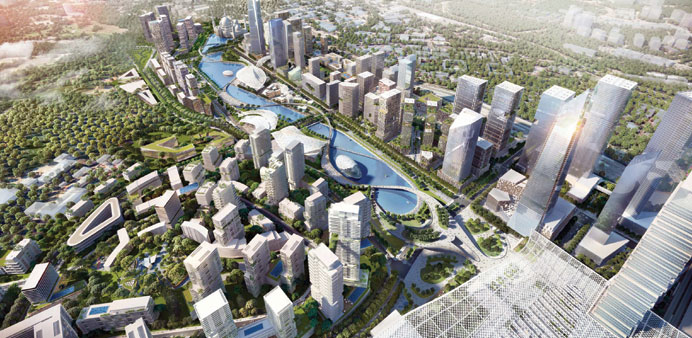Artist’s impression of the Bandar Malaysia project south of Kuala Lumpur’s city centre.
By Arno Maierbrugger
Gulf Times Correspondent
Bangkok
Bangkok and Kuala Lumpur have been put on the watch list of cities to become new global “super cities” in the coming years by international property consultant Knight Frank in its “Global Cities 2016” report, the latest edition of an annual research on the future of real estate in the world’s leading urban conglomerates.
The two Southeast Asian cities are joining Dubai, Nairobi and Moscow as candidates for “super cities” and the most vibrant and promising destinations for international real estate investment.
On the list of 21 existing global super cities, the usual suspects can be found, namely New York, London, Paris, Singapore, Hong Kong, Tokyo, Sydney and Los Angeles, but as of late also Mumbai, Delhi, Bengaluru, Shanghai, Beijing, Melbourne, San Francisco, Washington, Chicago, Mexico City, Sao Paulo, Frankfurt and Madrid.
John Snow, head of Commercial at Knight Frank, says that these cities are about to see “huge growth” up to 2020, and “their real estate markets need to be ready for new waves of citizens, firms and global investors.”
The UN forecast the global urban population to grow by 380mn people by 2020, which if correct means demand for city real estate is about to surge. Cities in high-income countries are projected to rise in population by 34mn by 2020, the equivalent of three cities the size of Paris. City populations in middle-income and emerging countries are forecast to contribute the rest, or about more than 14 cities the size of Shanghai.
“The development potential of this forecast growth is huge, when one considers all the new homes, offices, shops, logistics centres and infrastructure projects that such rapid expansion would necessitate,” Snow says. The positioning of Bangkok and Kuala Lumpur on this year’s watch list is owing to Bangkok’s rapidly expanding business districts and Kuala Lumpur’s new rail transit network that will include a fast connection to Singapore, boosting property value on the way.
In Bangkok, Knight Frank is particularly appalled by the development of a new business district in the northern part of the city centre around Ratchadapisek-Rama 9 roads with the massive Grand Rama 9 project. This cluster of high-quality office buildings includes the planned Super Tower, a 125-storey supertall structure with a height of 650 metres which on completion will be the tallest building in Southeast Asia. The tower will be divided into commercial offices and a luxury hotel and have a tourist observation deck. Developer Grand Canal Land has partnered with an affiliate of Skidwell Owings & Merrill, the same US-based architectural firm behind the Burj Khalifa in Dubai and the One World Trade Center in New York, as well as many iconic American skyscrapers. The project in Bangkok, which also includes new office buildings of Unilever and AIA insurance and the new Stock Exchange of Thailand’s head office, is expected to attract a large number of occupiers over the coming years.
In Kuala Lumpur, new rail transit lines and especially the eagerly awaited Kuala Lumpur-Singapore high-speed rail connection, likely to be completed by 2020 and designed to reduce travel time between the cities to 90 minutes, will create a number of development corridors along the Malaysian Peninsula and increase the speed of urbanisation there.
“Real estate opportunities are abundant along the route, and successful implementation will promote more development activity in the urban centres of Seremban, Malacca and Johor, as well as along the coastal corridor of Malaysia,” the Knight Frank report says.
There will also a huge benefit for the Bandar Malaysia development, a Qatar Investment Authority-backed mixed-use development just at the southern outskirts of Kuala Lumpur that will host the terminal station of the KL-Singapore high-speed railway.

